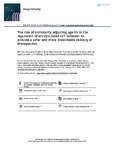| dc.contributor.author | González-Pujana, Ainhoa | |
| dc.contributor.author | Rementería, Aitor | |
| dc.contributor.author | Blanco García, Francisco J | |
| dc.contributor.author | Igartua, Manoli | |
| dc.contributor.author | Pedraz, José Luis | |
| dc.contributor.author | Santos-Vizcaíno, Edorta | |
| dc.contributor.author | Hernández, Rosa María | |
| dc.date.accessioned | 2020-03-18T09:38:49Z | |
| dc.date.available | 2020-03-18T09:38:49Z | |
| dc.date.issued | 2017-10-27 | |
| dc.identifier.citation | Gonzalez-Pujana A, Rementeria A, Blanco FJ, Igartua M, Pedraz JL, Santos-Vizcaino E, Hernandez RM. The role of osmolarity adjusting agents in the regulation of encapsulated cell behavior to provide a safer and more predictable delivery of therapeutics. Drug Deliv. 2017 Nov;24(1):1654-1666. | es_ES |
| dc.identifier.issn | 1071-7544 | |
| dc.identifier.uri | http://hdl.handle.net/2183/25187 | |
| dc.description.abstract | [Abstract] Transplantation of cells within alginate microspheres has been extensively studied for sustained drug delivery. However, the lack of control over cell behavior represents a major concern regarding the efficacy and the safety of the therapy. Here, we demonstrated that when formulating the biosystem, an adequate selection of osmolarity adjusting agents significantly contributes to the regulation of cell responses. Our data showed that these agents interact in the capsule formation process, influencing the alginate crosslinking degree. Therefore, when selecting inert or electrolyte-based osmolarity adjusting agents to encapsulate D1 multipotent mesenchymal stromal cells (MSCs), alginate microcapsules with differing mechanical properties were obtained. Since mechanical forces acting on cells influence their behavior, contrasting cell responses were observed both, in vitro and in vivo. When employing mannitol as an inert osmolarity adjusting agent, microcapsules presented a more permissive matrix, allowing a tumoral-like behavior. This resulted in the formation of enormous cell-aggregates that presented necrotic cores and protruding peripheral cells, rendering the therapy unpredictable, dysfunctional, and unsafe. Conversely, the use of electrolyte osmolarity adjusting agents, including calcium or sodium, provided the capsule with a suitable crosslinking degree that established a tight control over cell proliferation and enabled an adequate therapeutic regimen in vivo. The crucial impact of these agents was confirmed when gene expression studies reported pivotal divergences not only in proliferative pathways, but also in genes involved in survival, migration, and differentiation. Altogether, our results prove osmolarity adjusting agents as an effective tool to regulate cell behavior and obtain safer and more predictable therapies. | es_ES |
| dc.description.sponsorship | Gobierno Vasco; IT-907-16 | es_ES |
| dc.description.sponsorship | Universidad del País Vasco; UFI11/32 | es_ES |
| dc.language.iso | eng | es_ES |
| dc.publisher | Taylor & Francis | es_ES |
| dc.relation.uri | https://doi.org/10.1080/10717544.2017.1391894 | es_ES |
| dc.rights | Creative Commons Attribution 4.0 International License (CC-BY 4.0) | |
| dc.rights.uri | https://creativecommons.org/licenses/by/4.0/ | |
| dc.subject | Drug delivery | es_ES |
| dc.subject | Cell therapy | es_ES |
| dc.subject | Microcapsule | es_ES |
| dc.subject | Hydrogel | es_ES |
| dc.subject | Alginate | es_ES |
| dc.title | The role of osmolarity adjusting agents in the regulation of encapsulated cell behavior to provide a safer and more predictable delivery of therapeutics | es_ES |
| dc.type | info:eu-repo/semantics/article | es_ES |
| dc.rights.access | info:eu-repo/semantics/openAccess | es_ES |
| UDC.journalTitle | Drug delivery | es_ES |
| UDC.volume | 24 | es_ES |
| UDC.issue | 1 | es_ES |
| UDC.startPage | 1654 | es_ES |
| UDC.endPage | 1666 | es_ES |







